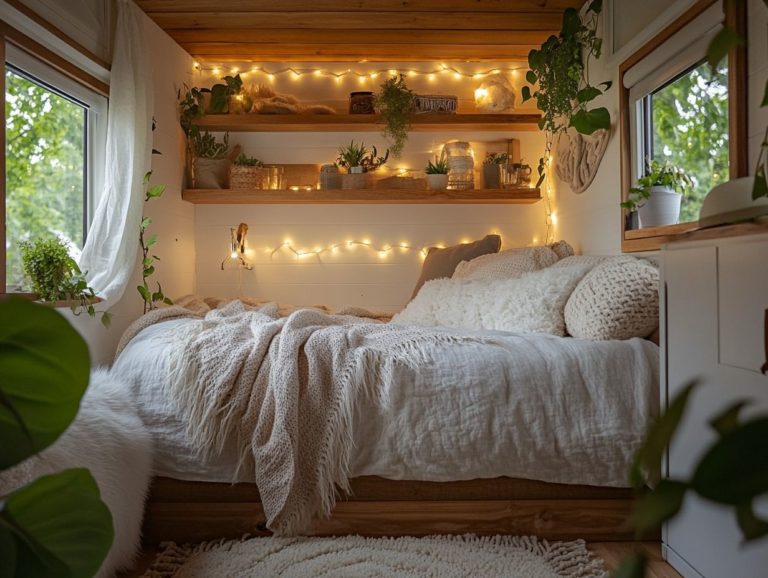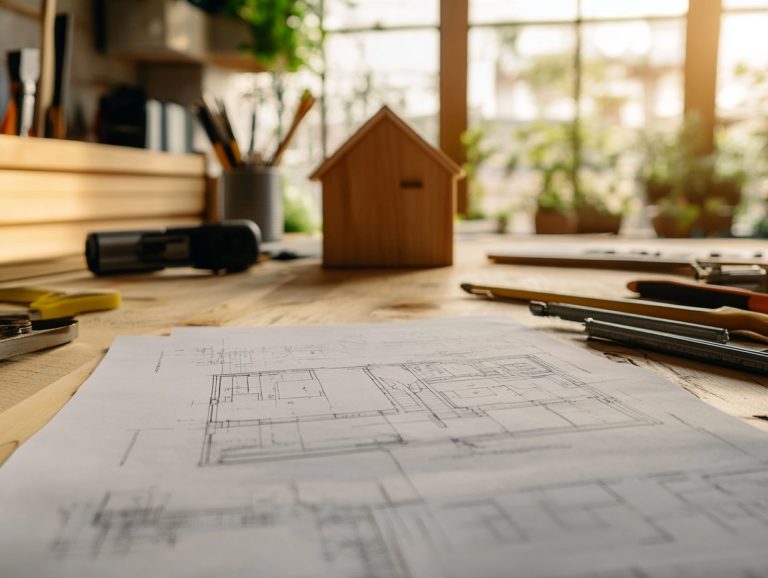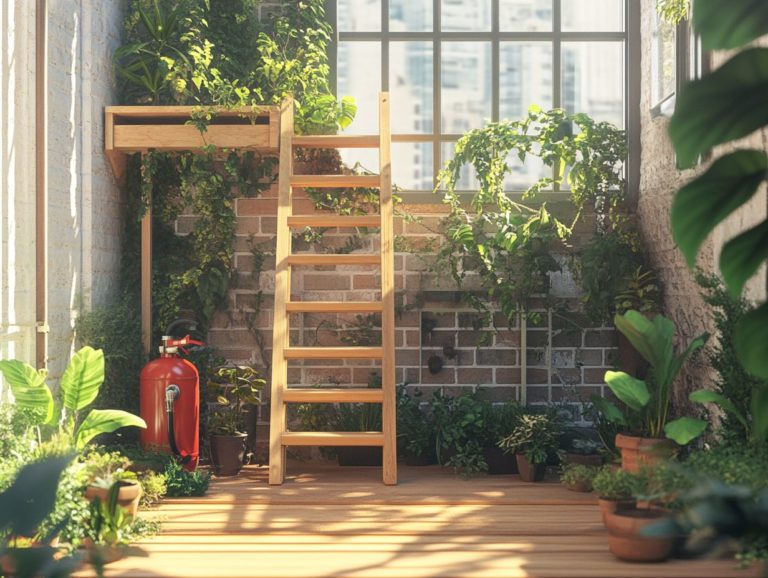How to Build Custom Tiny House Cabinets
Custom cabinets have the power to completely transform your tiny house. They seamlessly blend style with functionality.
This article explores the benefits of custom cabinetry. It also addresses the challenges you may face along the way.
You ll learn how to design your cabinets effectively. Identifying the materials and tools necessary for the task at hand is also included.
A detailed, step-by-step guide will walk you through measuring, cutting, and assembling your cabinets. Tips to help you sidestep common pitfalls are included as well.
We also provide maintenance advice to keep your custom creations in pristine condition.
Dive in and discover how to maximize every inch of your tiny space!
Contents [hide]
- Key Takeaways:
- Benefits and Challenges of Custom Cabinets
- Designing Your Custom Cabinets
- Materials and Tools Needed
- Step-by-Step Guide to Building Cabinets
- Tips for a Successful Project
- Maintenance and Care for Custom Cabinets
- Frequently Asked Questions
- What materials are needed to build custom tiny house cabinets?
- Do I need any special tools to build custom tiny house cabinets?
- How do I determine the correct size for my custom tiny house cabinets?
- What are some design considerations for custom tiny house cabinets?
- Can I use recycled materials to build custom tiny house cabinets?
- How can I make sure my custom tiny house cabinets are secure while on the road?
Key Takeaways:
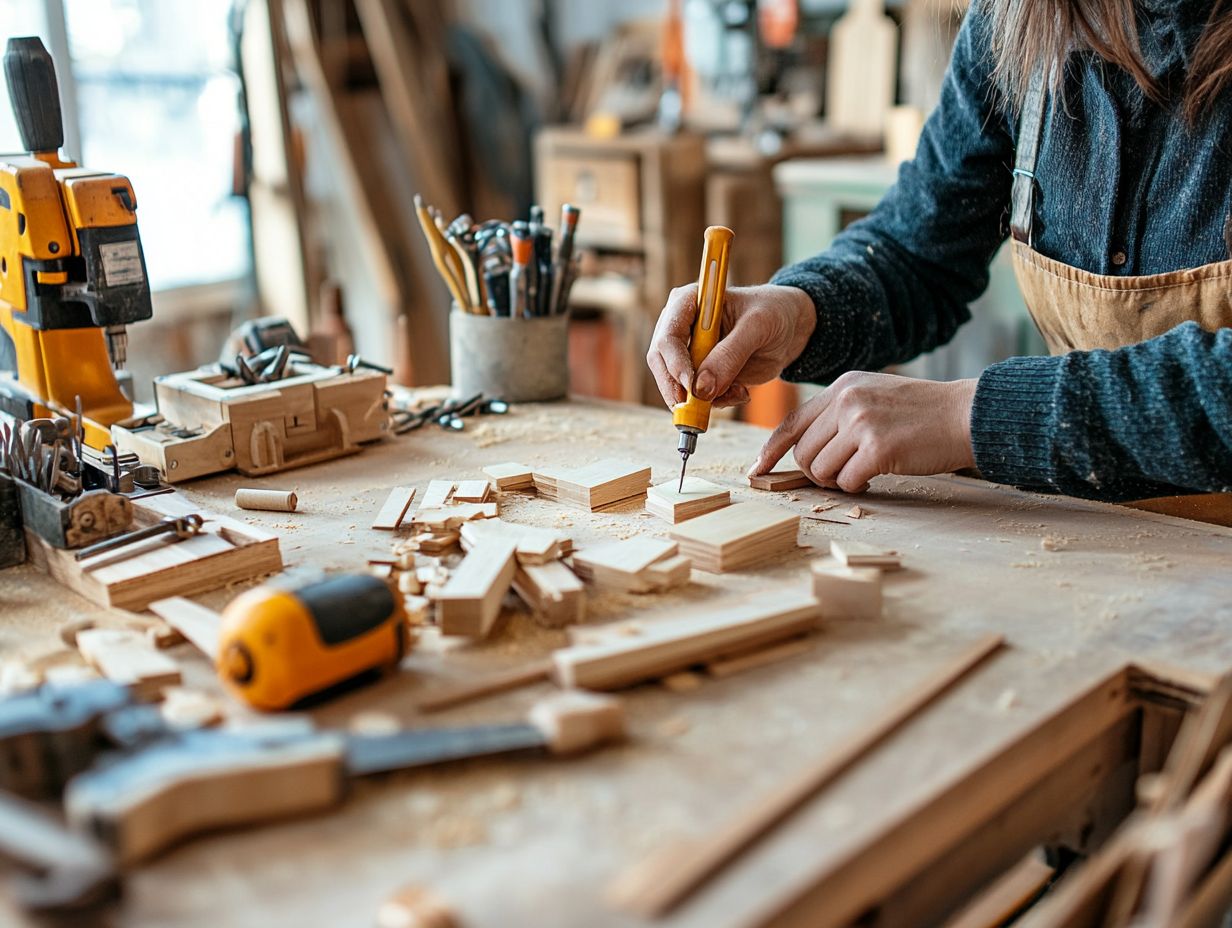
- Custom cabinets offer flexibility and uniqueness but require careful planning and execution to overcome challenges.
- Consider factors such as space, functionality, and style when designing custom cabinets.
- Recommended materials and tools for building custom cabinets include plywood, screws, and a table saw.
Benefits and Challenges of Custom Cabinets
Custom cabinets present a distinctive combination of benefits and challenges for homeowners aiming to optimize their kitchen space. By creating tailored solutions, you can maximize storage while ensuring every element integrates seamlessly into your overall kitchen design.
However, these advantages often come with potential hurdles, such as higher costs, longer lead times, and the need for DIY skills or professional installation. Grasping these factors is essential when contemplating an investment in custom cabinets, as they can significantly elevate your kitchen’s functionality and aesthetic appeal, all while posing specific challenges that demand thoughtful consideration.
Designing Your Custom Cabinets
Designing your custom cabinets requires a comprehensive understanding of several factors, including cabinet construction, material thickness, and the unique needs of your kitchen space, as acknowledged by the National Kitchen and Bath Association.
By tailoring the dimensions of your cabinets height, depth, and width you not only elevate the aesthetic appeal but also ensure they meet practical requirements.
A thoughtful design harmonizes form and function, enhancing your kitchen’s overall utility while offering a canvas for your creativity and personal expression.
Factors to Consider
When you re designing custom cabinets, several key factors demand your attention. The height, depth, and width of the cabinets are essential for maximizing storage solutions and ensuring functionality in your kitchen space. They play a pivotal role in the overall design, significantly influencing the working height and accessibility of your kitchen.
Each element should be tailored to your specific needs. This allows you to craft a harmonious environment that seamlessly blends aesthetics with practicality.
Besides the physical dimensions, consider the kitchen layout and how frequently you access certain items. For example, integrating pull-out shelves and lazy Susans can greatly enhance usability, making it a breeze to reach for cookware and pantry essentials.
Choosing the right materials and finishes is equally important, as they impact both durability and maintenance. Custom cabinets can be tailored to your individual storage preferences, accommodating everything from larger pots to delicate glassware, thereby elevating your cooking experience.
By thoughtfully evaluating these various factors, you re not simply investing in cabinetry; you re nurturing a kitchen that supports and inspires your culinary creativity.
Materials and Tools Needed
Creating custom cabinets demands a careful selection of materials and tools to guarantee both durability and functionality. Plywood stands out as a favored choice, thanks to its impressive strength and versatility.
A solid grasp of material thickness is crucial for crafting cabinets that can endure daily use while also delivering an aesthetically pleasing finish.
Tools like Titebond for adhesive bonding, pocket hole screws for secure joints, and drawer slides for smooth operation are essential. These elements are key to the cabinet-building process.
By equipping yourself with these essentials, you not only make your DIY project achievable but also set the stage for resounding success.
Recommended Materials and Tools
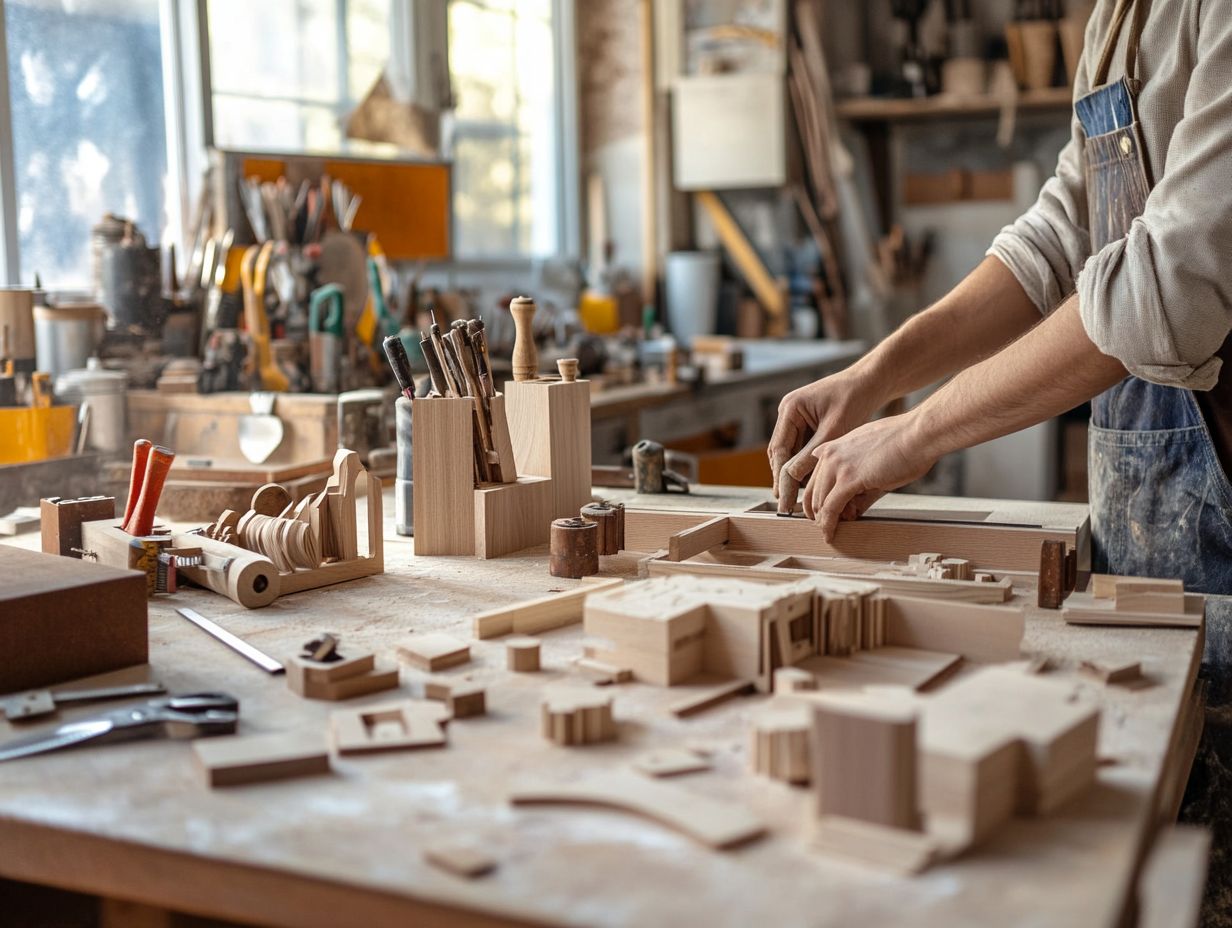
For successful cabinet construction, it s crucial to use high-quality materials and reliable tools. Plywood is often recommended for its strength and aesthetic potential, making it an excellent choice. For adhesive applications, Titebond is your go-to, while pocket hole screws screws designed to create strong joints at an angle help you create sturdy joints.
Efficient drawer slides are essential for ensuring smooth operation, allowing your DIY cabinets to function beautifully and stand the test of time. Selecting the right materials not only enhances the overall quality of your project but also contributes to a clean finish that elevates the beauty of your kitchen.
When you choose hardwoods for the faces and frames, paired with a durable finish, you can significantly boost the visual appeal and longevity of your cabinets. Using a miter saw will ensure precise cuts, fostering accurate assembly, while a quality drill makes the installation of all components a breeze. If you’re interested in more detailed guidance, check out this guide to building your own tiny house furniture. Incorporating soft-close hinges adds a touch of professionalism, preventing slamming and extending the lifespan of your cabinets.
These carefully selected tools and materials work together perfectly, allowing you to create kitchen cabinets that seamlessly blend functionality with style, satisfying both your practical needs and aesthetic desires.
Step-by-Step Guide to Building Cabinets
Building your own DIY cabinets is both a rewarding venture and a formidable challenge. It demands meticulous planning and execution, guided by a step-by-step approach that emphasizes measuring, cutting, assembling, and installing each component with precision.
- Take accurate measurements to ensure your cabinets fit seamlessly within your kitchen space.
- Cut your materials to the correct dimensions.
- Assemble with attention to detail to create cabinets that are not only sturdy but also visually appealing.
- The installation process transforms your vision into reality!
Measuring and Cutting
Accurate measuring and cutting are essential steps in cabinet construction that guarantee your finished product fits seamlessly into your kitchen space, with particular attention to height, depth, and width.
These precise measurements play a crucial role in both the functionality and aesthetics of your cabinetry. For instance, using a reliable digital caliper, a tool that measures small distances very accurately, can significantly enhance the accuracy of your dimensions. Employing a square ensures that your cuts are impeccably straight.
It s also advantageous to sketch out a detailed plan before you start cutting; this serves as a visual guide and helps minimize errors. Embracing techniques like the measure twice, cut once rule can instill confidence and precision in your work.
By concentrating on these fundamental aspects, you can achieve results that not only look polished but also stand the test of time.
Assembling and Installing
The assembling and installing phase of your DIY cabinets is where your hard work truly begins to take shape. This stage demands meticulous attention to detail and the precise use of tools like pocket hole screws to ensure everything fits together seamlessly.
Once your cabinets are assembled, the installation process comes into play. This involves securely fastening your cabinets to the wall and making necessary adjustments, such as fine-tuning drawer slides for optimal functionality. This is the moment your vision takes shape, enhancing the aesthetic appeal of your kitchen.
To achieve a flawless finish, it’s crucial to adopt a systematic approach, starting with accurate measurements of your space to ensure proper alignment. Using essential assembly tools such as levels and clamps will ensure each cabinet is positioned perfectly, preventing future issues like warping or structural failure. A strong emphasis on secure construction is vital; making sure each joint is tightly fitted can significantly enhance durability. For those looking to enhance their skills in building, you might consider checking out this guide to planning your DIY tiny house build.
Taking the time to carefully install additional hardware, like hinges and pulls, will not only improve functionality but also elevate the elegance of your completed kitchen project.
Tips for a Successful Project
Creating custom cabinets can be an incredibly rewarding DIY endeavor. Here are several tips that can help you achieve success, particularly in kitchen design and innovative ideas.
Careful planning helps you avoid common mistakes like inaccurate measurements or low-quality materials. By recognizing these pitfalls, you can streamline the process and attain a superior outcome. Prioritizing preparation not only elevates your experience but also guarantees that your cabinets will function seamlessly and enhance the aesthetic of your kitchen space.
Mistakes to Avoid
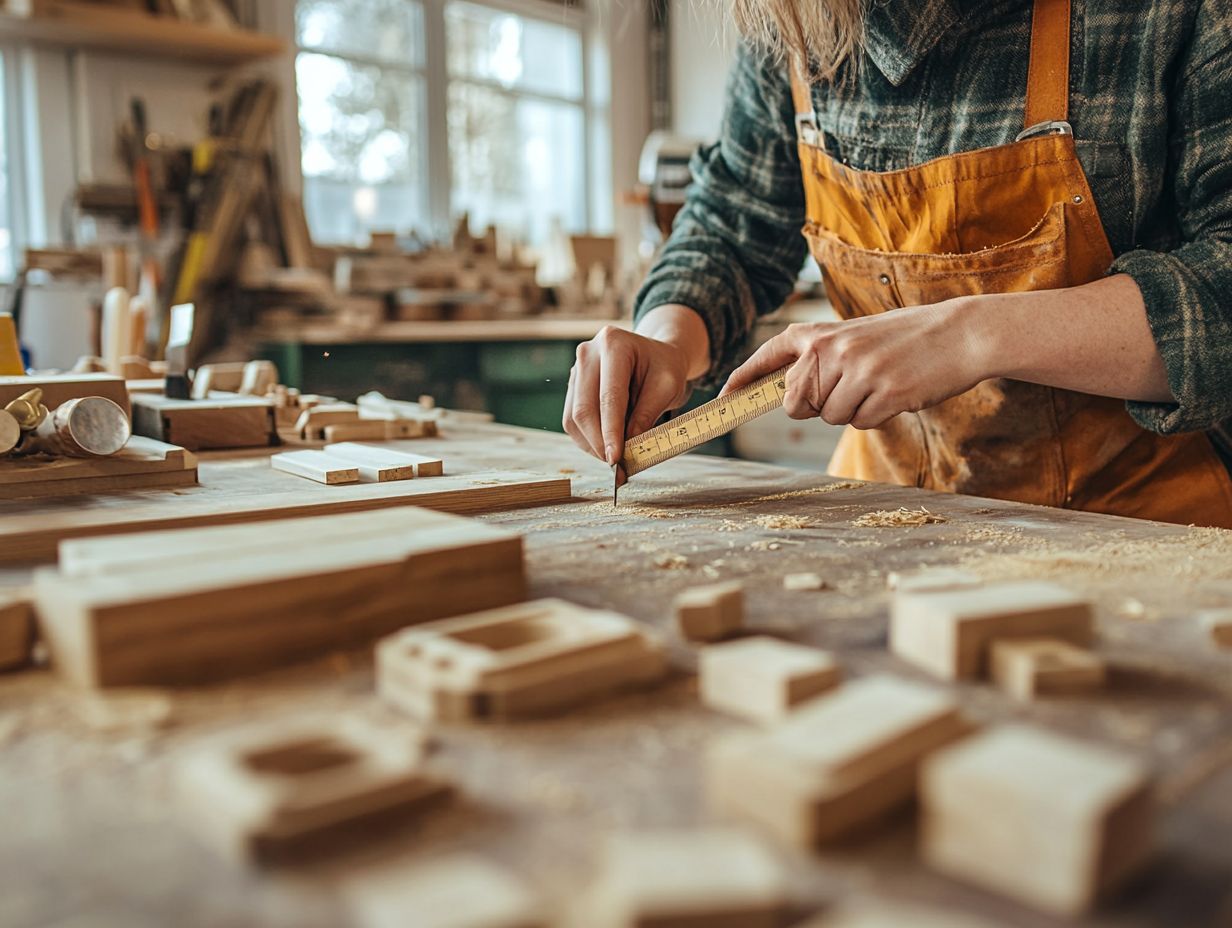
When you embark on a DIY cabinet project, it’s crucial to be mindful of common missteps that can undermine both functionality and aesthetics. Many DIY enthusiasts often underestimate the significance of precision, which can lead to misaligned cabinets or doors that refuse to close properly.
Identifying these pitfalls in advance allows you to take proactive steps to ensure a seamless building process, ultimately crafting cabinets that elevate your kitchen design.
For instance, double-checking your measurements before making any cuts is imperative. A minor mistake can snowball into costly and time-consuming adjustments later on. Investing in quality tools is also a wise move, as they can dramatically enhance the accuracy of your cuts.
When it comes to installation, pay attention to leveling your cabinets. Uneven surfaces can create frustrating gaps and misalignments. Proper fastening techniques are essential; using the right hardware ensures stability and the longevity of your custom cabinets.
By considering these elements, you can transform your DIY adventure into a gratifying success.
Maximizing Space and Functionality
Maximizing space and functionality in your kitchen is one of the key benefits of choosing custom cabinets. They empower you to create tailored storage solutions that cater precisely to your needs.
By strategically designing your cabinets to utilize every inch of available space, you can ensure your kitchen is not just visually appealing but also operates with impressive efficiency. Features like:
- Pull-out shelves
- Deep drawers
- Adjustable heights
all contribute to a well-organized and user-friendly kitchen design.
Taking advantage of vertical space adds another dimension of storage. Imagine overhead cabinets reaching all the way to the ceiling, perfectly housing seasonal items or rarely used appliances. Incorporating corner cabinets with lazy Susans—a rotating tray that makes accessing items easier—or pull-out systems prevents wasted space and keeps everything within easy reach. For those looking to maximize their storage options, check out this step-by-step guide to DIY tiny house shelves.
Thoughtful lighting integrated into your custom cabinetry not only enhances visibility but also elevates the overall aesthetic appeal of your kitchen ambiance.
Ultimately, these innovative design choices do more than just improve storage capabilities; they elevate the overall functionality and style of your kitchen space, transforming it into a true culinary haven.
Maintenance and Care for Custom Cabinets
Keep your custom cabinets looking great and working well with regular care! Regular maintenance is crucial to preserving their pristine finish and ensuring long-lasting functionality in your kitchen.
Engaging in simple practices such as:
- Dusting the surfaces
- Steering clear of harsh chemicals
- Employing suitable cleaning methods
will keep your cabinets shining and lasting longer!
Familiarizing yourself with the specific requirements of the materials used be it plywood or other options empowers you to maintain their beauty and utility over time, ultimately elevating your entire kitchen experience.
Start planning your custom cabinet project today and consider incorporating a Murphy bed to maximize space and watch your kitchen transform!
Keeping Cabinets Clean and Functional
Maintaining your custom cabinets in pristine condition requires a diligent routine that caters to both beautiful look and practical functionality. Regular cleaning not only elevates the visual allure of your cabinets but also ensures they operate seamlessly, preventing pesky issues like sticky drawers or stubborn doors.
By integrating straightforward cleaning techniques and familiarizing yourself with the specific materials’ properties, you can significantly extend the lifespan of your cabinets while preserving a stunning kitchen ambiance.
Opt for soft, damp cloths instead of abrasive sponges, which can damage surfaces. For tougher stains, a gentle detergent mixed with water usually does the trick. Steer clear of harsh chemicals that could undermine finishes over time. Make it easy on yourself! Regularly checking hinges and tracks for dust or debris keeps everything running smoothly and hassle-free.
Establish a monthly cleaning schedule to wipe down surfaces and assess any signs of wear and tear. A proactive approach keeps your custom cabinetry clean and functional, allowing you to enjoy your kitchen without compromising on style or efficiency.
Frequently Asked Questions
What materials are needed to build custom tiny house cabinets?
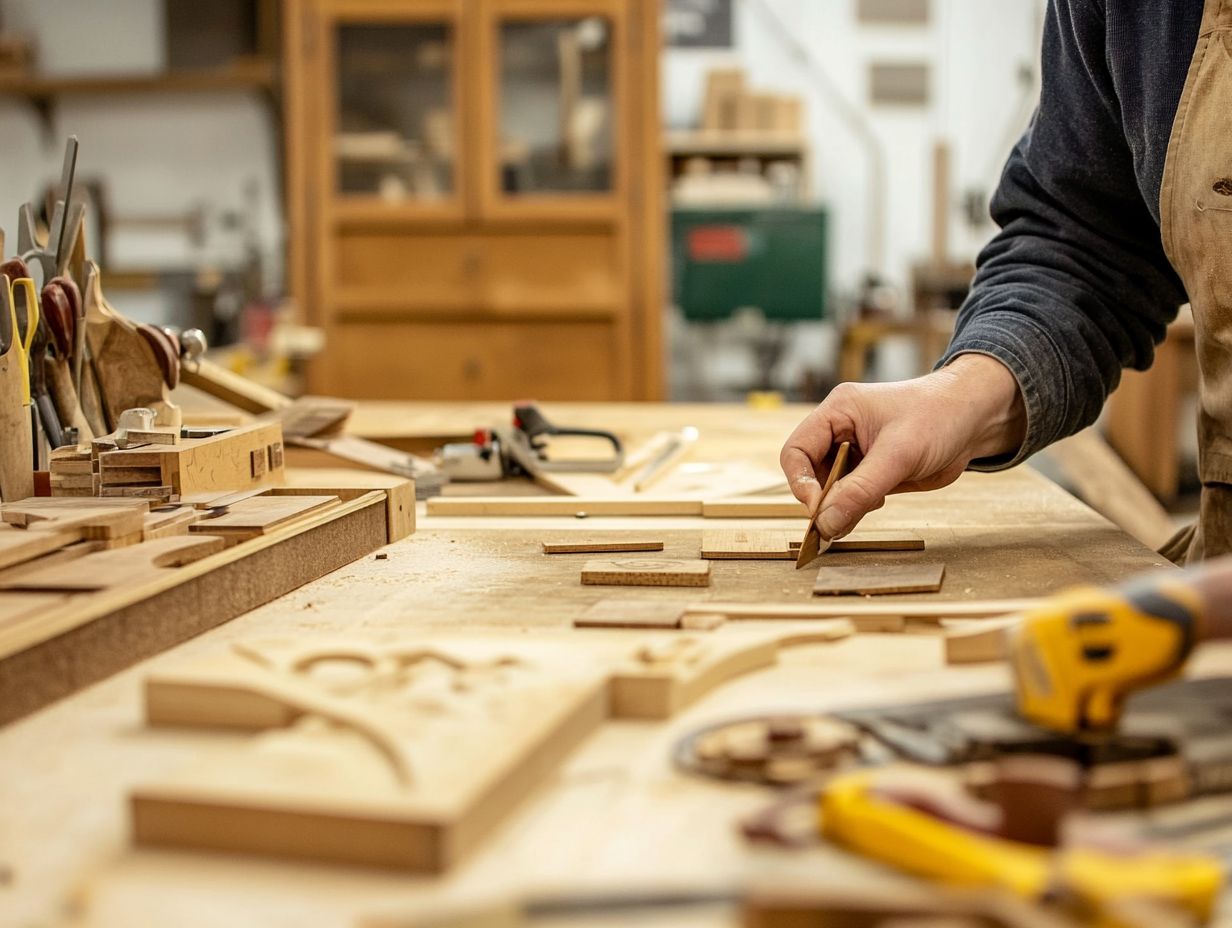
To build custom tiny house cabinets, you will need wood boards, screws, hinges, nails, a saw, a drill, sandpaper, and a measuring tape. You may also need additional materials such as stain or paint, depending on your preference.
Do I need any special tools to build custom tiny house cabinets?
A basic set of tools will suffice, but having a pocket hole jig and a table saw will make the building process easier and more precise. However, you can still build custom tiny house cabinets without these tools.
How do I determine the correct size for my custom tiny house cabinets?
The size of your cabinets will depend on the available space in your tiny house and your storage needs. Measure the area where the cabinets will be installed and consider what items you will be storing. Leave some extra space for hardware and any decorative trim you plan to add.
What are some design considerations for custom tiny house cabinets?
In addition to functionality, consider incorporating space-saving features such as pull-out shelves or built-in organizers. You can also customize the appearance of your cabinets by adding trim, different types of wood, or unique hardware.
Can I use recycled materials to build custom tiny house cabinets?
Absolutely! Using recycled materials not only saves money, but it also adds character and sustainability to your tiny house. Look for old cabinets, doors, or wood from salvage yards or thrift stores.
How can I make sure my custom tiny house cabinets are secure while on the road?
If you plan on traveling with your tiny house, it’s important to ensure your cabinets are securely fastened. Use heavy-duty screws to attach the cabinets to the wall studs and consider adding latches or locks to keep the doors closed during transit.
Whether you’re building or maintaining, the right tools and techniques will keep your tiny house cabinets looking great and functioning well!



